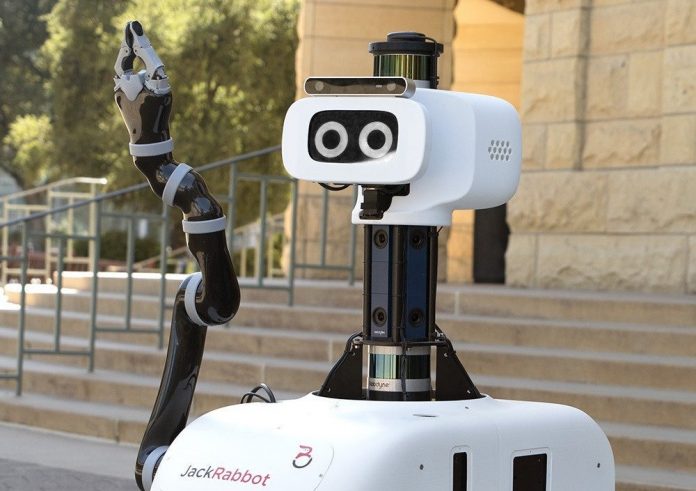Looking into the future it seems essential to make humans robot friendly as well to develop such kind of robots to assist humans in their daily life chores.
A team of researchers from Standford University has developed JackRabbot 2. It has a squat body, friendly eyes and a two-fingered arm tasked with learning to move around and between humans. It is an update of the stylish JackRabbot.
In the beginning, JackRabbot was designed with an intention to get robots closer to humans so that they can work as a generalized personal assistant. It would help in delivering packages, cleaning house and grabbing a snack from the fridge.
Silvio Savarese, associate professor of computer science, who leads the JackRabbot project, said, “The JackRabbot project is developing a robot that doesn’t just navigate an environment by following the behavior of a traditional robotic system, such as going from Point A to Point B and avoiding bumping into obstacles.”
“We want a robot that is also aware of the surroundings and the social aspects of human-robotics interactions, so it can move among humans in a more natural way.”
Versatile features of JackRabbot 2
- Robotic arms are used to interact with physical objects, such as opening a door or picking up a container.
- Other than this usual feature JackRabbots’ versatility lead it to other intentions such as signaling a person to go ahead or stop with hand gestures.
- Facial expressions and sounds help it to communicate with the people around.
- It is also equipped with sensors to help it navigate the world. These sensors comprised of multiple depth-sensing and stereo cameras, GPS and three LIDAR sensors, which can send and detect pulsed laser light to define the surrounding environment in 3D.
- The new robot will require estimated data of at least 24 hours in various environments- indoors and outdoors during different times of day, in crowds of varying density and configuration- to teach the AI algorithm which would allow JackRabbot 2 to navigate autonomously with humanlike etiquette.
Ashwini Pokle, a graduate student in the Stanford Vision and Learning Lab, said, “There are many behaviors that we humans subconsciously follow – when I’m walking through crowds, I maintain personal distance or, if I’m talking with you, someone wouldn’t go between us and interrupt.”
“We’re working on these deep learning algorithms so that the robot can adapt these behaviors and be more polite to people.”
Data collection process includes:
- Training the algorithm on pre-existing videos featuring all kinds of modes of transportation: walkers, skateboarders, bicyclists, and people on scooters.
- The group will also crowdsource data from a video game where people maneuver a simulation of JackRabbot 2 through online environments.
- For some real-world exposure, the researchers take JackRabbot 2 out for walks, navigating it manually in the way they want it to someday move.
Roberto Martín-Martín, a postdoctoral fellow in the Stanford Vision and Learning Lab, said, “Every time we go around campus or outside, we want to collect all of the data that the robot perceives through its sensors.”
“We train the robot to understand these data and infer things like ‘Where are people in these images?’ or ‘How do I move if I receive this sensor data?”
JackRabbot and JackRabbot 2 were designed deliberately cute. They named for Stanford’s resident jackrabbits. This is all to make people comfortable since these robots will wander among pedestrians. A team has designed JackRabots very shrewd that the robots had to learn what an in-coming hug looks like and how to pause for selfies.
This is the smart attempt to bridge the gap between large-scale delivery hubs and individual businesses or homes. Robots have to learn to coordinate between two completely different environments that delivery hubs are less defined by rules and boundaries than roads where autonomous cars roam.
At Stanford, the immediate expectation of researchers is to have JackRabbot 2 try out its delivery-bot skills on campus.
